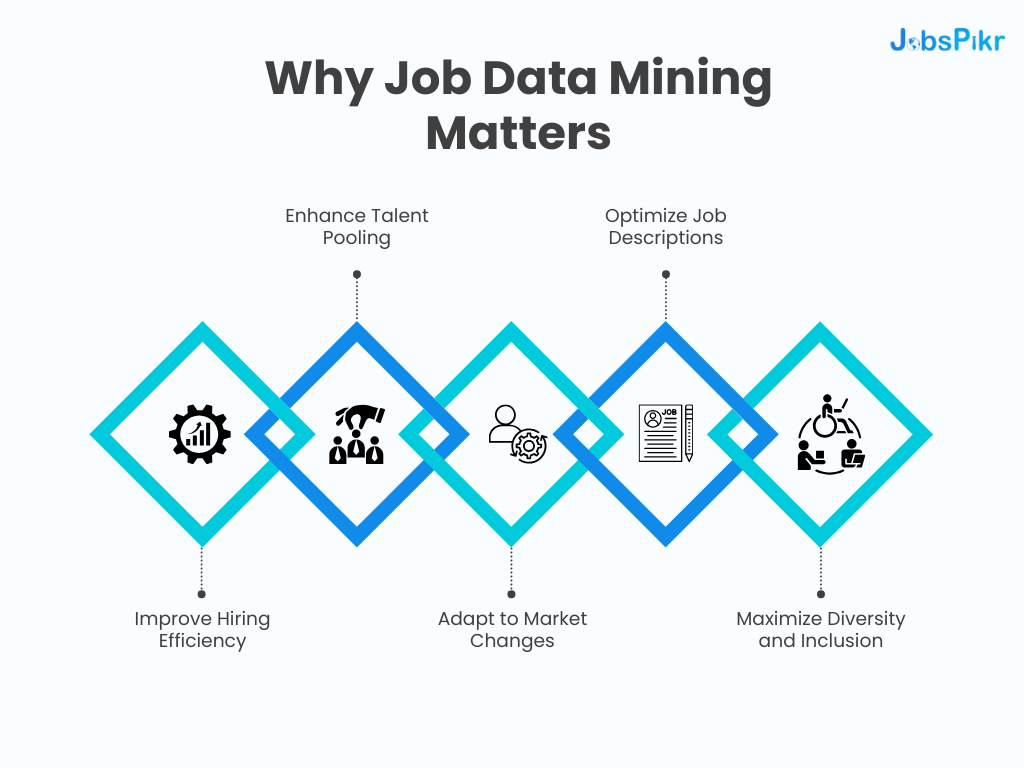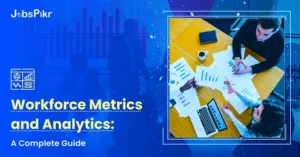Recruitment agencies are continually searching for ways to refine their hiring processes and improve decision-making. One powerful method for achieving this is job data mining, which involves extracting valuable insights from vast job datasets. By leveraging advanced data mining techniques, agencies can unearth trends, make informed predictions, and stay ahead in the competitive job market.
This comprehensive guide will delve into the techniques and tools used in job data mining, highlighting how businesses can extract actionable insights from workforce data.
What is Job Data Mining?

Image Source: Rutgers
Job data mining refers to the process of analyzing large job-related datasets to discover patterns, trends, and valuable insights that can help optimize recruitment strategies and improve business decision-making. This method involves leveraging technologies such as machine learning, artificial intelligence (AI), and statistical algorithms to sift through data points from job postings, employment records, and workforce metrics.
With increasing amounts of job data available from sources like job boards, social media, resumes, and HR systems, the importance of analyzing this data to enhance recruitment efforts cannot be overstated. By implementing job data mining strategies, recruitment agencies can streamline their operations, better understand the job market, and make more informed hiring decisions.
Why Job Data Mining Matters?
The modern job market is highly dynamic and complex. Recruitment agencies are often overwhelmed by vast amounts of information, making it difficult to stay competitive. Through job data mining, agencies can:

- Improve Hiring Efficiency: By analyzing historical hiring patterns and trends, agencies can predict which candidates are most likely to succeed in specific roles, reducing time-to-hire.
- Enhance Talent Pooling: Mining job data allows agencies to tap into a wider talent pool by identifying relevant candidates who may not be actively seeking a job but possess the necessary skills.
- Adapt to Market Changes: Job market data analysis helps recruitment firms understand shifting trends in job demand, emerging skills, and industries that are gaining or losing traction.
- Optimize Job Descriptions: Agencies can leverage insights from job data to create more targeted and compelling job descriptions, attracting qualified candidates.
- Maximize Diversity and Inclusion: Data-driven approaches can uncover biases in hiring and help design strategies that promote diversity and inclusion.
How the Data Mining Process Powers Job Data Analysis?
The data mining process for job data involves several steps that allow businesses to extract valuable information. The general process can be broken down into the following key stages:

Image Source: ConsumerNotice
1. Data Collection
The first step in any data mining process is data collection. For recruitment agencies, this means gathering job-related data from multiple sources, such as job boards, social media, company websites, and resume databases. Sources can include structured data, such as job descriptions, employment history, and salary information, as well as unstructured data, like candidate interactions, social media profiles, and online reviews.
2. Data Cleaning
Once data has been collected, it often needs to be cleaned to ensure its accuracy and relevance. This step involves removing inconsistencies, duplicates, and irrelevant data points that could skew the analysis. Since job datasets are typically large and diverse, data cleaning is crucial for ensuring the quality of insights that are later extracted.
3. Data Transformation
The next step is data transformation, where the raw data is organized into a format that is suitable for analysis. This involves standardizing job titles, skills, and qualifications, as well as categorizing data into relevant groups, such as industries, job levels, or regions. Recruitment agencies often use natural language processing (NLP) techniques to extract meaningful information from unstructured text in job descriptions or resumes.
4. Data Mining
This is the core step where actual mining of data occurs. Various data mining techniques are applied to uncover hidden patterns, correlations, and trends. For job data mining, the following techniques are particularly useful:
- Classification: This technique helps categorize job data based on predefined labels, such as job type, industry, or skill level.
- Clustering: Clustering groups similar data points together, such as grouping job applicants based on similar qualifications or skills.
- Association Rule Learning: This identifies relationships between different data points, such as the correlation between specific skills and job success rates.
- Regression Analysis: Recruitment agencies use regression models to predict outcomes, such as the likelihood of a candidate being hired based on their qualifications.
- Text Mining: This is particularly important for analyzing unstructured job descriptions and resumes. Text mining uses algorithms to identify relevant keywords and match candidates to open positions.
5. Data Interpretation and Visualization
Once patterns have been discovered, the next step is interpreting the results and making them actionable. Data interpretation is where recruitment agencies make sense of the insights and translate them into strategic decisions. Visualization tools, such as graphs, charts, and dashboards, are commonly used to present the findings in an understandable format. Effective data visualization allows stakeholders to grasp key insights at a glance.
6. Data Deployment
The final stage involves putting the mined insights into action. For recruitment agencies, this could mean optimizing job postings, refining candidate search strategies, or adjusting the company’s overall hiring approach based on the analyzed data. The insights gathered through job data mining can help agencies continuously improve their processes.
Essential Job Data Mining Techniques for Recruitment Insights
To make the most of job data mining, recruitment agencies must be familiar with a variety of data mining techniques. These methods enable them to discover hidden patterns and trends within job market data, ensuring more effective hiring decisions.
1. Predictive Analytics
One of the most powerful techniques in job data mining is predictive analytics, which involves using historical data to make informed predictions about future outcomes. For recruitment agencies, predictive analytics can forecast which candidates are most likely to succeed in specific roles based on past hiring data, job performance, and market trends. This method can significantly reduce the time spent on recruitment by narrowing down the candidate pool to those with the highest potential.
2. Natural Language Processing (NLP)
NLP is a critical tool for analyzing unstructured text data, such as job descriptions, resumes, and cover letters. By using NLP algorithms, recruitment agencies can automatically extract key phrases and categorize candidates based on their skills, experience, and qualifications. NLP enables companies to process large volumes of text-based data quickly, making it easier to match candidates with job postings.
3. Sentiment Analysis
In today’s digital age, job seekers and employees frequently leave reviews on job boards and social media. Sentiment analysis uses text mining and NLP to assess the tone and sentiment of these reviews, offering agencies insights into the perception of specific companies or job roles. By monitoring public sentiment, agencies can better align their hiring strategies with job seeker expectations.
4. Machine Learning
Machine learning is a vital tool in job data mining, particularly when it comes to predictive modeling and classification tasks. Machine learning algorithms can automatically learn from past data to improve future predictions. In the recruitment context, machine learning models can be used to rank candidates based on their likelihood of success, flag resumes that match specific job descriptions, and even predict how long a new hire will stay with the company.
5. Clustering and Segmentation
Clustering involves grouping similar data points together, which can be useful when analyzing job applicants with similar skills or qualifications. For recruitment agencies, clustering techniques can be used to segment the job market, dividing candidates into groups based on experience, industry, or geographic location. By segmenting the job market, agencies can better target their recruitment efforts.
Best Tools to Enhance Your Job Data Mining Process
Job data mining requires the right tools to efficiently process, analyze, and visualize large datasets. Here are some popular tools used by recruitment agencies:
1. JobsPikr
One of the leading tools for job data mining, JobsPikr, allows recruitment agencies to extract real-time job market data from multiple sources such as job boards, company websites, and more. It offers features like job data APIs, customizable data feeds, and market trend analysis, making it an invaluable resource for workforce data mining. With JobsPikr, agencies can stay updated on the latest trends and quickly adapt their hiring strategies.
2. Tableau
Tableau is one of the most popular data visualization tools, allowing users to create interactive charts, graphs, and dashboards. For job data mining, Tableau helps recruitment agencies interpret the data, making it easier to identify trends and patterns. With its intuitive interface, agencies can quickly gain insights into the job market and optimize their strategies accordingly.
3. Python
For those looking to take a more customized approach to job data mining, Python is a powerful programming language often used in data analysis. Libraries like Pandas and Scikit-learn make it easy to perform tasks such as data cleaning, transformation, and predictive modeling. Recruitment agencies with in-house data science teams can use Python to create tailored solutions for their specific hiring needs.
Top Applications of Job Data Mining in Recruitment
Job data mining is not just about identifying patterns in data; it has real-world applications that benefit recruitment agencies in several ways:

1. Job Market Forecasting
Agencies can use data mining to predict future trends in the job market. By analyzing historical job data, they can forecast which industries are likely to see job growth, what skills will be in demand, and how salary trends are likely to evolve. This helps agencies align their hiring strategies with future market demands.
2. Optimizing Talent Acquisition
Data mining allows agencies to optimize their talent acquisition processes by identifying the most efficient sourcing channels, predicting candidate success rates, and streamlining the hiring process. This can lead to a more effective and efficient recruitment strategy, reducing costs and time-to-hire.
3. Workforce Planning
Workforce data mining can help agencies understand demographic shifts, skill shortages, and other workforce trends. This information is critical for workforce planning, allowing companies to anticipate hiring needs and avoid talent shortages.
4. Candidate Screening and Matching
By analyzing candidate data and job requirements, job data mining helps improve the accuracy of candidate screening and matching processes. This reduces the risk of bad hires and improves overall job placement success.
Conclusion
In the highly competitive job market, recruitment agencies need every advantage they can get, and job data mining offers the tools and techniques necessary to stay ahead. From predictive analytics to NLP and machine learning, the right data mining strategies enable agencies to gain valuable insights from job datasets, optimize their hiring processes, and make data-driven decisions.By investing in the right tools and technologies, such as JobsPikr agencies can effectively mine job data to forecast trends, improve candidate matching, and make better hiring decisions. As job data mining continues to evolve, those who harness its power will undoubtedly have a competitive edge in the recruitment industry. Sign up today!




